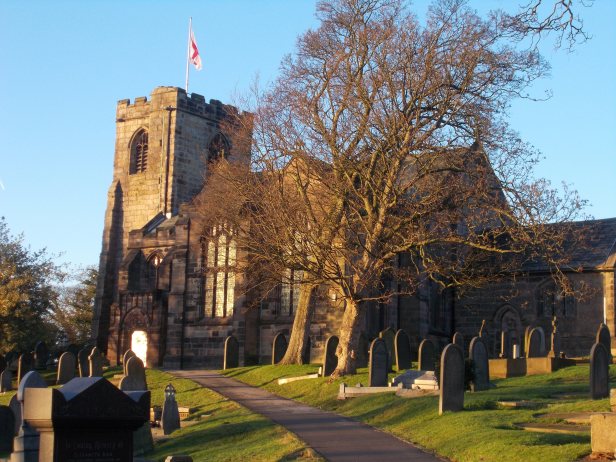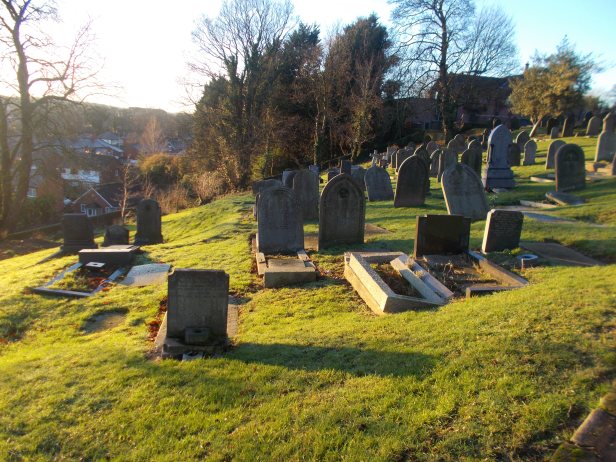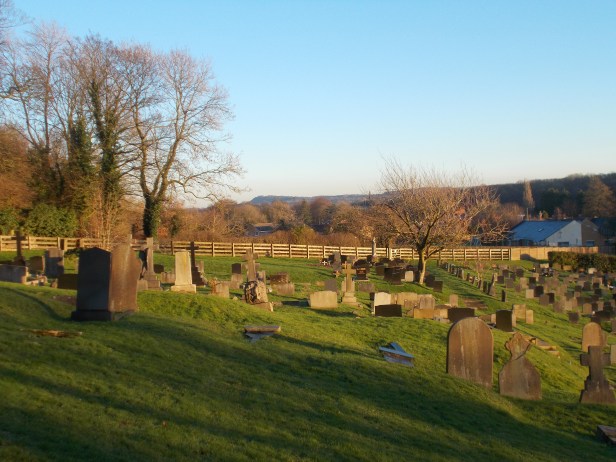There is a story told about Edward Kelley, a well-known Tudor alchemist and psychic fraudster, that concerns his nefarious activities one night in Walton-le-Dale. He is said to have spoken to devils and raised a dead man’s corpse to find out the future fate of a local landowning gentleman. Over the centuries since the event is supposed to have taken place, the story has mutated to include his later companion Dr. John Dee, astrologer to Queen Elizabeth I. Now many websites and local books on folklore tell different versions of the story, but what are its origins and how much truth could there be in the tale?

The story was first published in a book by John Weever, a Preston man who studied at Cambridge University in the years 1594 to 1598. After university, he returned to Lancashire for a few years before going down to London where he entered literary society as a contemporary of William Shakespeare and Ben Johnson.
From 1600 onwards, he spent three decades collecting inscriptions from tombs. He published them in his 1631 book Ancient Funeral Monuments, the year before he died. In a chapter named “Of the punishments both by human laws and God’s severe justice, inflicted upon such malefactors, in foregoing ages, who violated sepulchres. Of church robbers, priests, witches” he relates a tale told to him first-hand by a servant who claims to have witnessed the events, and by the gentleman in question whose future was being divined. He declines to name the gentleman, probably to protect him from association with Edward Kelley’s illegal magic. However, modern research indicates that the gentleman was probably Thomas Langton, lord of the manor of Walton-le-Dale.
In his account, Weever first tells us that Edward Kelley had lost his ears at Lancaster (which probably meant he had the top part of his ears cut off as criminal punishment at Lancaster Castle). He mentions Kelley’s stay with Rudolph the Second, Emperor of Germany and his subsequent serious injuries following a severe fall during an escape attempt. The injuries led to Kelley’s death, in 1598, which Weever saw as divine punishment for his wicked deed that had taken place years before in Walton-le-Dale. Weever then goes into details about what is supposed to have happened that night.
The story concerns how the gentleman’s servant first went with Edward Kelley to speak to a demon in Walton Park. They then travelled up to the churchyard of St Leonard’s to raise a dead man and make a demon speak through him. The reasons this necromancy was carried out was to find out what might happen to the gentleman Thomas Langton in his future, and when he would die.

Below we lay out the story, as written by John Weever, in his own words. First, Edward Kelley and his accomplice Peter Waring speak to a demon to learn about what might befall the gentleman and how and when he will eventually die:
Then thus this diabolical questioning of the dead, for the knowledge of future accidents, was put in practice by the fore said Kelley; who, upon a certain night, in the park of Walton in le Dale, in the county of Lancaster, with one Peter Waring (his fellow companion in such deeds of darkness) invocated someone of the Infernal Regiment to know certain passages in the life, and also what might be known by the Devil’s foresight, of the manner and time of the death of a noble young gentleman, as then in his wardship.
Kelley then gets the gentleman’s servant to take him to St Leonard’s Church (which stands on a hill called Walton Law). There they dig up a man who had been buried that day and make a demon speak through his corpse to give them more predictions about the gentleman’s life:
The black ceremonies of that night being ended, Kelley demanded of one of the gentleman’s servants what corpse was left buried in Law church-yard, a church there onto adjoining, who told him of a poor man who was buried there but the same day. He and the said Waring intreated this aforesaid servant to go with them to the grave of the man so lately interred, which he did; and withal did help them to dig up the carcass of the poor caitiff, whom by their incantations, they made (or rather some evil spirit through his organs) to speak, who delivered strange predictions concerning the said gentleman.
Finally, Weever tells us how he came to know the story, through the servant telling him what happened, and a version also told to him by the gentleman:
I was told so much by the serving man, a secondary actor in that dismal abhorred business; and divers gentlemen and others are now living in Lancashire to whom he hath related this story. And the gentleman himself (whose memory I am bound to honour) told me a little before his death of this conjuration of Kelley; as he had it by relation from his said servant and tenant; only some circumstances excepted; which he thought not fitting to come to his master’s knowledge.

Is this history or folklore?
What are we to make of all this? The fact that the story is written by John Weever, who lived in the same time period as Edward Kelley, gives the tale some credence. It has also been told to him by the servant and the gentleman. We know that Weever’s father had been in the service of Thomas Langton, and had been on trial for murder with thirteen others after the feud between the Langtons and the Hoghton family led to the death of Thomas Hoghton. (For more on this, see our Broughton Tower page here). What the outcome of the trial was for Weever’s father is unknown, but Langton seems to have taken Weever under his wing and, as his protégé, sent him to Cambridge University.
So, in summation this appears to be a contemporary account of the charlatan Edward Kelley doing pretend necromancy to persuade onlookers that he could speak to spirits or devils. A further fact is that it is well documented that Kelley went on to fame (or infamy) claiming he could speak to angels, persuading Dr John Dee of this ability, which also lends credence to the tale.
A later telling
A later version of the story claims that Dr Dee was present on the night at Walton-le-Dale. In this version the corpse was not a pauper, but a wealthy man. He was raised so that Dee and Kelley could question him as to where he had hidden his money. This does sound like folklore. Folklorists Westwood and Simpson claim that this was first recorded in Causbon’s A True and Faithful Relation of what passed for many Years Between Dr John Dee and Some Spirits published in 1659. (Lancashire Past Author’s note: I have looked through the Causbon book a number of times but I find no record of this version of the story. In fact Causbon just repeats Weever’s own version, word for word. Other sources claim that this later story comes from the 1911 version of the Encyclopaedia Britannica, but I have not been able to track this down.) It is this later, more folkloric, version that appears in many local history and folklore books, and on folklore websites.
Although Dr John Dee is only associated with this story through folklore, there is good historical and documentary evidence for his involvement with The Seven in Lancashire. This is a tale of alleged demon possession and witchcraft at Cleworth Hall, near Tyldesley. Read our account here
Site visited by A. Bowden 2019
Access
St Leonard’s CE Church in Walton-le-Dale sits on top of Church Brow. There is parking in front of the church.
Walton Park would have been the parkland around Walton Hall. The hall is long gone, but Walton Hall Farm is still there. Nearby is Dog Kennel Wood, which would have been part of the parkland that still survives. It can be visited and is a semi-natural broadleaf woodland. See the Woodland Trust page here. Park on Hennel Lane.
On the same site
St Leonard’s Church, Walton-le-Dale
Nearby, just a short walk away
Walton-le-Dale’s Lost Roman Military Site
Just a short drive away
Preston’s Lost Medieval Friary
The Lost Leper Hospital of St Mary Magdalene,
References
archive.org/details/antientfuneralm00weevgoog/page/n12
en.wikipedia.org/wiki/John_Weever
en.wikipedia.org/wiki/Edward_Kelley
John Weever : A biography of a Literary Associate of Shakespeare and Johnson, E.A.J. Honningman (1987) Manchester University Press
The Lore of the Land: A Guide to England’s Legends from Spring-Heeled Jack to the Witches of Warboys Jennifer Westwood and Jacqueline Simpson (2005) Penguin Books
woodlandtrust.org.uk/visiting-woods/woods/dog-kennel-wood/
‘Townships: Walton-le-Dale’, in A History of the County of Lancaster: Volume 6, ed. William Farrer and J Brownbill (London, 1911), pp. 289-300. British History Online http://www.british-history.ac.uk/vch/lancs/vol6/pp289-300 [accessed 19 October 2019].
archive.org/details/truefaithfulrela00deej/page/n8 for Meric Causbon’s A True and Faithful Relation of what passed for many Years Between Dr John Dee and Some Spirits
Comments are closed.